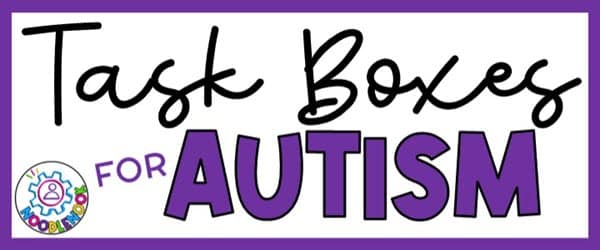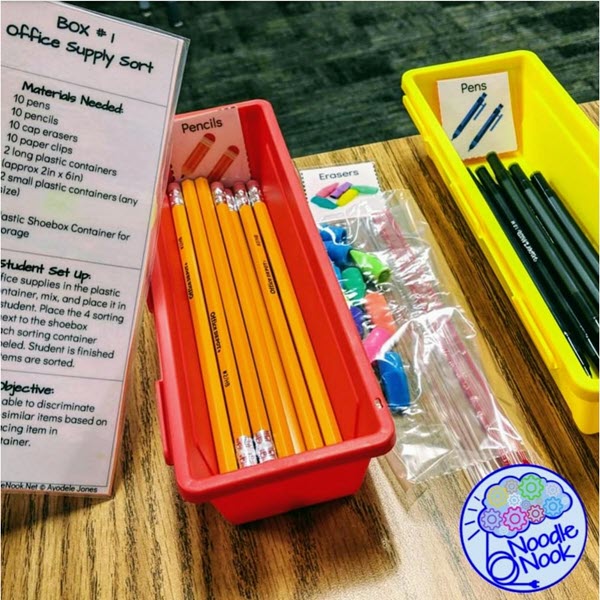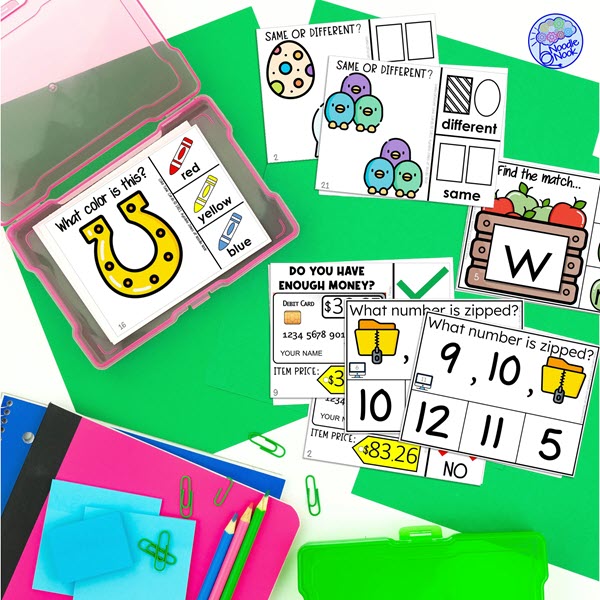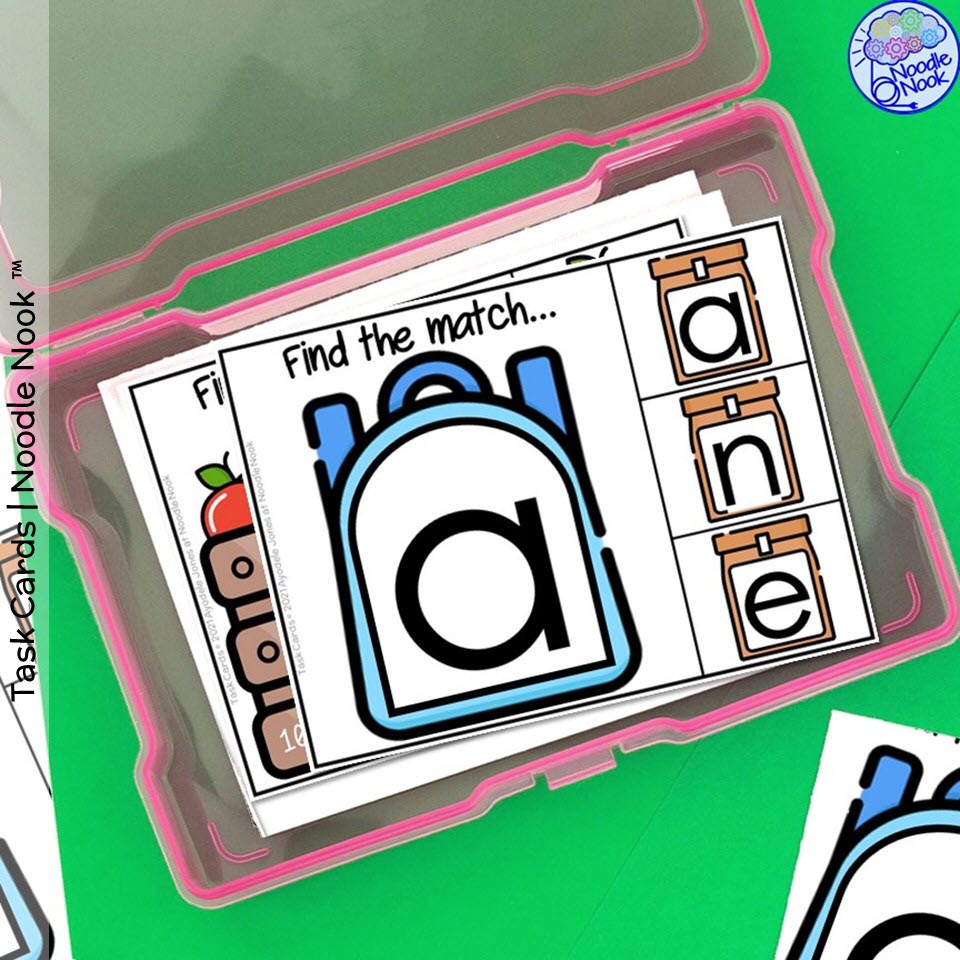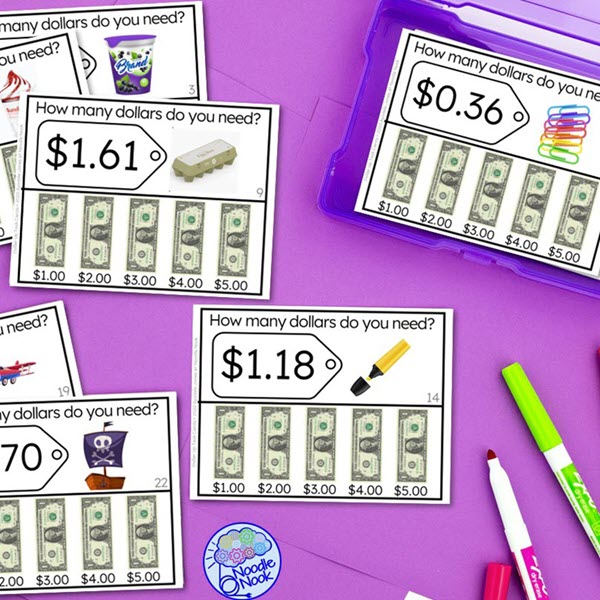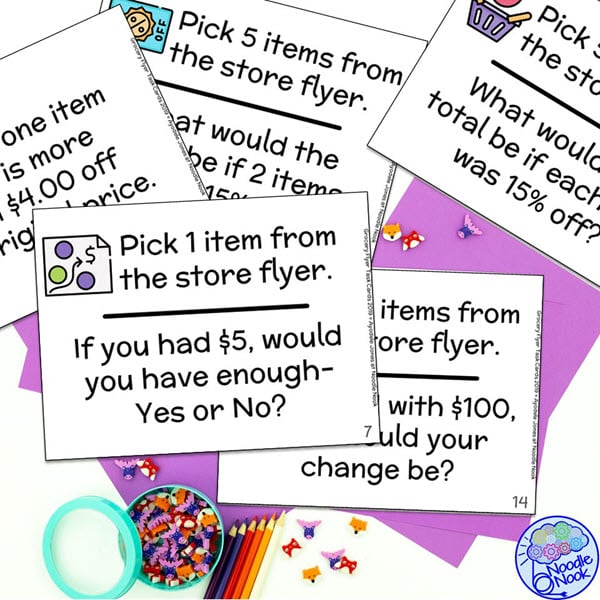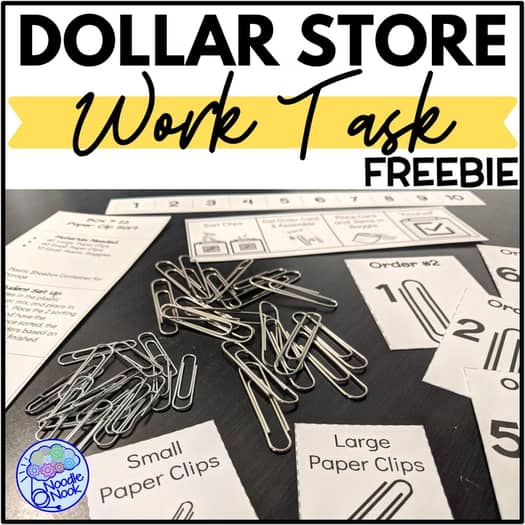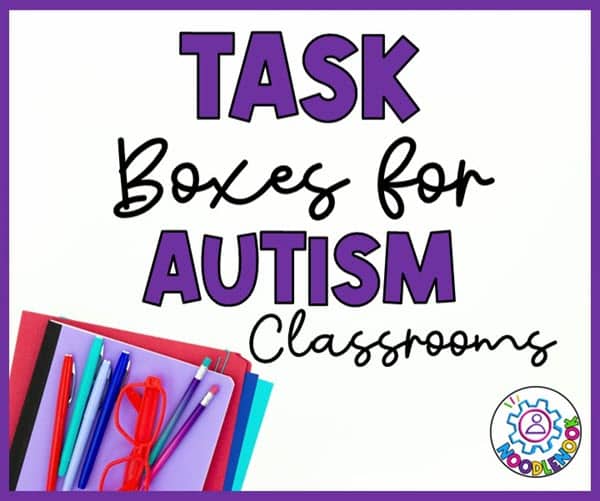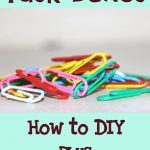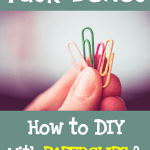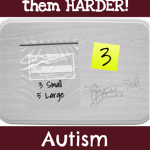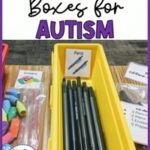You need Autism classroom task boxes for vocational training in your classroom. Trust me. They are a great way to improve skills, build independence, and save your sanity! BUT… You also want them to be meaningful and actually teach new skills. Better yet, you want them to target IEP goals and functional skills for real life! No worries, we got you covered. Here are a few quick task box ideas for autism classrooms so you have more variety with your work boxes in special education learning environments.
What are Task Boxes?
Task boxes are like mini learning kits. They’re simple containers, like shoeboxes or folders, filled with fun and educational activities. These activities help students in special education practice important skills. A single task box targets a specific skill, making it a great way to learn things like math or reading.
Here’s the cool part: Task boxes allow students to work on their own. Each task box or file folder activity has everything a student needs to do all the work. That means you can grab a box that targets a specific skill and get students working fast. And that means teachers can focus on other things while students learn and have fun. Task boxes are all about making learning more hands-on, engaging, and exciting.
Why are Task Boxes Helpful in Special Ed?
As a special education teacher, you should be absolutely thrilled at the idea of task boxes in your classroom. Not only are they a great way to support autistic children and special education students as they learn and practice skills, but they are also an easy way to develop fine motor skills, basic skills, and independent work skills.
- Concrete Supports and Hands-On Learning. The primary way that task boxes are helpful in special education classrooms is because of their hands-on nature. For students with autism, these tangible activities offer a clearer learning path and higher engagement. This type of concrete and active learning truly caters to students on the spectrum.
- Perfect for Independent Work Systems. In special education, our students are working on a variety of tasks. That’s why implementing independent work stations is a great way to target specific skills for each student. Moreover, a work task system is one of the best ways to build independence, break prompt dependence, and improve soft skills.
- Task Variety. Using task boxes can help special education teachers target educational and behavioral goals for students on the autism spectrum. With some foresight, you can create task boxes that target the skills your students are lacking. On top of that, since there’s something that you can reuse over and over again, it’s easy to build a lot of variety. Plus, they are total time savers since they work on so many different skills.
The takeaway here is that it’s a great idea to incorporate task boxes in your classroom, they work with young children all the way through young adult students as the best way to focus on basic skills and higher level tasks. So, let’s dive into some task box ideas for autism classrooms!
Ideas for Task Boxes in Autism Classrooms
As you build your independent work tasks for students with autism and complex access needs, know this: There is a lot of variety! You can have shoebox tasks, work task boxes that target vocational skills, task cards that include clip cards, as well as file folder activities and hands-on learning stations. Honestly, there’s no end to the possibilities when it comes to task box ideas for autism classrooms!
As you get started, It’s a good idea to take stock at the beginning of the school year of your students’ goals and objectives as well as your own materials that you have on hand. Then, target these easy to make task box ideas for autism and students with disabilities:
Academic Task Box Ideas
I love having a solid set of task boxes that can be used to teach basic skills. I try to have a set available to target site words specifically as well as writing and comprehension. My students also love boxes that include environmental print. Doesn’t love an activity that uses wrappers from your favorite foods? Here are a few easy to make tasks to get started:
- Sight Word Match-Up: Fill a task box with flashcards containing sight words. Provide corresponding word cards with missing letters. Students match the missing letters to form the complete sight word. Try this one with CVC onsets and rimes!
- Count and Sort: Place a variety of objects (e.g., buttons, paperclips) in a task box. Students count the objects and sort them into separate compartments within the box based on quantity. If you love these types of put-in tasks, then read all the way to the bottom and score your free activity!
- Number Puzzles: Create number puzzles by cutting apart number cards. Students must assemble the puzzle by arranging the numbers in the correct numerical order within the task box. You can easily do this with popsicle sticks by writing numbers on them!
- Story Comprehension: I love to include a social story for comprehension as a task box filler. It supports skills my students always struggle with. Check out the task cards with images illustrating different behaviors that come in the social story bundle.
- Basic Math Operations: Include task cards with simple addition and subtraction problems in the task box. Students solve these problems using manipulatives like counters, buttons, or play money. To get a set of play money printables free, visit this blog post.
- Sentence Building: Create sentence stems or close sentence strips for students to complete. Students look at an image, process it, and use task box materials to build a sentence for it. If you want to see one up close, check out this one.
- Vocabulary Building: Fill a task box with word cards and matching image cards. Students match the word with the corresponding image, enhancing their vocabulary and comprehension. I like hands on learning for early skill building. Check out this set of sentence frame cards that work on vocabulary.
- Number Puzzles: Design puzzles that help students understand numbers and the relationships between them. They match the numbers that make up a given total, promoting numeracy skills and basic addition understanding. I love to build basic math skills with these simple missing number task cards in my independent work center.
There are so many ways to incorporate educational goals into the task box system, so grab some different shapes, some foam letter sets, or a handful of farm animals and make a learning task! You can do it, promise.
Pre-Vocational Task Box Ideas for Autism
Task boxes are critical in teaching skills related to real-life situations and work environments. I love to use them as a counterpart to our classroom-based business. That way all my students are busy all of the time, even if I don’t have enough staff to man multiple centers or stations. If you want to read more about opening a classroom enterprise, then check out this post on starting a Classroom Coffee Cart. *
- Item Sorting: Provide a task box with buttons of various sizes, colors, and shapes. Students sort the buttons into compartments based on specific characteristics, developing fine motor skills and attention to detail. It’s easy to make with pipe cleaners or other simple items that you have in the classroom.
- Shoe Matching: Include cards with images of different shoes and shoeboxes in your task box. Students match the shoes to the appropriate shoebox, simulating a real-life sorting task.
- Money Skills: Develop task cards with images of coins and bills. Students count and match the correct amount of money to the corresponding price tag on another card, practicing basic money-handling skills. I love this one for the grocery store that also targets functional skills.
- Product Packaging: Create mini versions of product packaging (e.g., food containers, toy boxes). Students match products to their appropriate packages, reinforcing the concept of packaging in a vocational context. This set includes ones that use materials from Dollar Tree!
- Counting Inventory: Provide task cards with images representing inventory items, each with a specific quantity. These are digital-based, so they are done at a computer station (which improves engagement for some). My students loved the pet shop the most!
- Simple Assembly: Prepare task cards illustrating basic assembly instructions (e.g., connecting pieces or fastening objects together). Students follow these instructions using task box materials. This printable set of task boxes each includes assembly tasks. Plus, because all the manipulatives are printable, it’s easy to get started. On top of that, each of the monthly themes has a different set of symbols. This makes it easy to keep things fresh while still addressing a core set of skills.
Task boxes are a great place to begin teaching pre-vocational skills, especially for older students and young adults.
Functional Skills Task Boxes
How can task boxes help with functional skill development? How can they not? It’s so easy to put in materials that support real-world skills. Try these on for size:
- Grocery Shopping Skills: Provide task cards with images of common grocery items and a shopping list or grocery flyer. Students use the task box to find the items and match them to the list, practicing essential grocery shopping skills. This activity is perfect as a work task box for building skills like these!
- Household Chores: Develop task cards depicting household chores such as sweeping, mopping, or folding laundry. Students use the task box to match the chore with the correct tool or object needed to complete it, promoting independence in daily living skills. I like this one that is all about where things are located in the home. Check it out here.
- Money Management: In this task box, include task cards with scenarios like buying a snack or paying for a bus ticket. Students use play money or coins to make the correct payment, honing their money management skills. Every student I know needs to work on money skills. This dollar up activity is perfect in a task box.
- Facial Expression Matching: Behavior goals are also easy to target task boxes autism style! Students can sort different facial expressions or emotions as a way to develop functional skills. I gave away a set of these to my email subscribers recently. If you aren’t in the community yet, consider joining. That way you won’t miss out on awesome freebies, helpful strategies, and blog roundups.
Idea to Implement TODAY – A Quick DIY Task Box
Making new task activities can feel overwhelming. What can you put together to make something that actually works for your students? It really is not that bad… once you know what you are looking for.
The easiest way to start?
Every classroom I know of has an infinite number of paper clip boxes… Grab a box of large and a box of small and let’s get started!
Most teachers who work in Vocational Prep or Life Skills will look at those two boxes and see a simple sorting task. What more can you do?
Grab a box of Ziploc baggies and let’s move this from Sorting to Assembly. Your directives will change… Students will put one small and one large clip into the Ziploc.Bam! Much more than sorting.
Want to kick it up another notch? Add a Sharpie marker. Label about 10-15 baggies with some combination of small and large paper clips. Something like this: 3 small, 5 large
Be sure to mix up the combinations on several baggies. Voila! Now you have a more challenging task.More Complex Task Boxes
Need even more complexity? Got you there too. You will take what you already have and add a stack of Post-its. Take as many Post-Its as you have baggies and write some numbers on them from 1-5. Now insert one Post-It with a number on it into a baggie with the ‘order’ on it. That is the number of orders that baggie needs so, with the same order as above plus a Post-It with ‘3’ on it your students would put in:
- 9 small
- 15 large
Now a student has gone from simple sorting, to some assembly and up to order fulfillment. This is an easy method for increasing the complexity of task boxes, which is especially useful for higher-level goals and older students. Not all students would be able to fulfill an order without some kind of visual aid. Remember a number line will greatly help students be successful.
Increasing Complexity of Task Boxes
In the example above, you can see how the activity went from sorting to something more.
Recap real quick of the paper clips: A Level 1 student is sorting, a Level 2 is doing assembly, Level 3 is doing order fulfillment, and Level 4 is doing assembly & order fulfillment. All with 2 boxes of paper clips. It can be easy to take this model to whatever you have sitting around your desk. Got a stack of pencils and pens? Works with those. How about plastic forks and spoons? Yup- you can do this too.
If you are starting from scratch and are looking for more easy-to-make task boxes, check out this Noodle Nook bestseller; Dollar Store Task Boxes, More Dollar Store Task Boxes, and Task Box Bundle.
The important part to remember is that the simple task of sorting needs to be made into something more. Think of ways to incorporate assembly and order fulfillment into your work systems. Also, remember how important the idea of task box rotation can be in keeping students engaged and learning a variety of skills.
FREE Task Box!
If you love the idea of DIY task boxes or Autism classroom task boxes, then score this FREEBIE! You can snag this paper clip DIY task box from the Noodle Nook store. I love this and I’m sure you will too. This printable makes it easy to create a free task box from materials you already have in your classroom. How can you lose?
RECAP: Task Box Ideas for Autism Classrooms
The main goal of using task boxes in the special education classroom is to support students with disabilities to develop independent skills and reinforce learning objectives. I love to have a set available for work stations as they offer a clear beginning and end of a learning cycle. That supports my students in learning, but also in becoming more employable and building functional skills. As you create materials for your work system and add more task boxes, remember they are something you can use this year but also next year and every year after! That means it is time and money well spent. Good luck!
This post was originally published on November 8, 2017.

